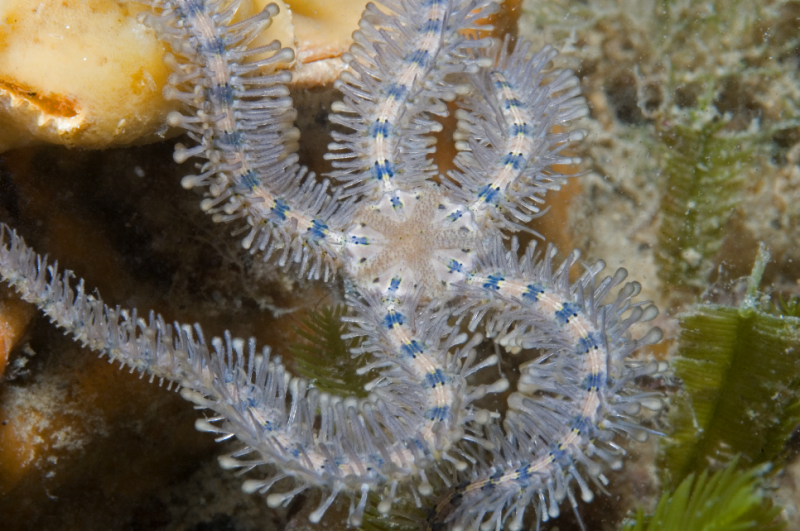May 12, 2016 report
Brittle star study reveals richness and diversity of deep-sea life

(Phys.org)—A team of researchers from Canada, the U.K. and Australia has compiled a dataset of brittle stars from across the globe and in so doing have offered a new way for biologist to view the richness of deep-sea life. In their paper published in the journal Nature the team describes the lengths they went to in attempting to add samples to their database, some details of what they found and possible uses for such a database.
It has been noted that the deep-sea is one of the least studied parts of our planet, which could be a problem in the coming years as technology advances and resources are discovered beneath the sea floor, causing humans to roam the depths. At this time, little is known about what impact human exploration or mining could have on the deep-sea, or whether such activities would translate to a negative impact on creatures that live in the oceans in general. In this new effort, the researchers sought to shed some light on animal diversity in the deep-sea, by counting brittle star population and diversity numbers for specimens that have been pulled from the ocean going back to 1872—they suggest that brittle star diversity could very well be a barometer for gauging animal populations for different parts of the ocean in general. Brittle stars are a good choice, they note, because they are so ubiquitous—the live in every ocean at virtually every depth.
The study consisted of logging data about brittle stars from published papers, museums, fishing logs, etc, which amounted to approximately 1,600 sources. In all the team recorded data for approximately 165,000 specimens covering approximately 2,000 species. As part of the data collection, the researchers included where each brittle star had lived when it was alive, which allowed the team to create maps that showed brittle star population estimates and diversity levels all across the globe.
In studying their maps (which were divided into three categories based on ocean depth), the researchers found that as expected the greatest diversity of brittle stars was in the tropics, but, unexpectedly, they found that the areas that had the greatest number of species was not the tropics, but instead were at mid-latitudes, which includes a lot of very deep-sea areas. This the researchers suggest, is likely due to the massive amounts of plankton that live in these areas, die and drop to the bottom, where brittle stars feed on them.
More information: Skipton N. C. Woolley et al. Deep-sea diversity patterns are shaped by energy availability, Nature (2016). DOI: 10.1038/nature17937
Abstract
The deep ocean is the largest and least-explored ecosystem on Earth, and a uniquely energy-poor environment. The distribution, drivers and origins of deep-sea biodiversity remain unknown at global scales. Here we analyse a database of more than 165,000 distribution records of Ophiuroidea (brittle stars), a dominant component of sea-floor fauna, and find patterns of biodiversity unlike known terrestrial or coastal marine realms. Both patterns and environmental predictors of deep-sea (2,000–6,500 m) species richness fundamentally differ from those found in coastal (0–20 m), continental shelf (20–200 m), and upper-slope (200–2,000 m) waters. Continental shelf to upper-slope richness consistently peaks in tropical Indo-west Pacific and Caribbean (0–30°) latitudes, and is well explained by variations in water temperature. In contrast, deep-sea species show maximum richness at higher latitudes (30–50°), concentrated in areas of high carbon export flux and regions close to continental margins. We reconcile this structuring of oceanic biodiversity using a species–energy framework, with kinetic energy predicting shallow-water richness, while chemical energy (export productivity) and proximity to slope habitats drive deep-sea diversity. Our findings provide a global baseline for conservation efforts across the sea floor, and demonstrate that deep-sea ecosystems show a biodiversity pattern consistent with ecological theory, despite being different from other planetary-scale habitats.
Journal information: Nature
© 2016 Phys.org


















